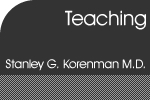

|
<< Previous Section | < Previous Page | Next Page > | Next Section >>
Bibliography (page 7 of 11) Saunders, C., A. Sugar, et al. (1999). "What's the Price of a Research Subject?" N Engl J Med 341(20): 1550-52. This collection of letters in response to Dickert and Grady's July 15 article gives a full range of opinions on the topic of paid research subjects. They are nice replies. http://content.nejm.org/cgi/content/full/341/20/1550 Rothman, K. J. and K. B. Michels (1994). "The Continuing Unethical Use of Placebo Controls." N Engl J Med 331(6): 394-398. The authors argue that placebos violate the basic principle of protection, and that they are being overused in research studies. Although old, it provides ethical justification for the revised Declaration of Helsinki. The authors recommend holding study designers accountable for misuse of placebos as well as stricter enforcement of placebo use requirements. A worthwhile read and is a cornerstone of the minimizing placebo use argument. Russo, E. (2002). "The Biological Basis of the Placebo Effect." The Scientist: 30-31. This approachable article gives empirical evidence, including PET scans and trial results, which illustrate placebos' positive treatment effects. Though the article does not mention it, this evidence endangers the placebo's place as a controlled way to examine trial results. Shapiro, H. T. and E. M. Meslin (2001). "Ethical Issues in the Design and Conduct of Clinical Trials in Developing Countries." N Engl J Med 345(2): 139-142. From the National Bioethics Advisory Commission a discussion of what ethical standards should be used for research overseas with particular attention to developing countries. This article takes the position that standards cannot be relaxed and that control subjects should receive the best therapy available in the developed world even though it will likely not be available after the trial. The authors also deal with key issues including informed consent, research review, and post trial benefits to participants and their community. They discuss the use of placebos as well. Spiegel, D., H. Kraemer, et al. (2001). "Is the Placebo Powerless?" N Engl J Med 345(17): 1276-1279. These are a series of responses to Hrobjartsson and Gotzsche's article examining their methods and critiquing their results. The letters provide wonderful additional analysis to the article and are well worth reading. Steinbrook, R. (2003). "Trial Design and Patient Safety -- The Debate Continues." N Engl J Med 349(7): 629-630. The article gives an account of OHRP's recommendations on two disputed clinical trials for treatment of acute respiratory distress syndrome (ARDS). The OHRP concluded that in both cases the IRBs released informed consent documents that were too vague. Sung N., Crowley W J et al. (2003). "Central challenges facing the national clinical research enterprise." JAMA 289(10): 1278-87. This is an excellent position paper identifying the weaknesses underlying clinical research in the US. These are inadequate public trust and participation, lack of effective computerized systems to manage the data and other inefficiencies resulting in high costs, an inadequately trained work force, physicians included, and inadequate funding from the usual sources. These inadequacies have resulted in blockage of the translation of basic research into clinical studies and the blockage of the translation of clinical research results into clinical practice. They would like to see these issues addressed and improvement in the apparatus for bringing improved therapy into the lives of patients. Vieira, C. (2002). "Brazil. Tough placebo rules leave scientists out in the cold." Science 295(5553): 264. Brazil's ban of all placebos in cases where effective treatment was available has drawn criticism from the country's clinical researchers. Although the policy protects subjects, it also closes them to novel therapies and significantly slows the rate of research. http://www.sciencemag.org/cgi/content/full/295/5553/264 << Previous Section | < Previous Page | Next Page > | Next Section >> |
Chapter 3 Quick Links Ethics and Study Design Introductory Ethics Design Appropriate Risk to Benefit Ratio Selection of Subject Populations Cases Bibliography Chapter 3 Download (PDF) |